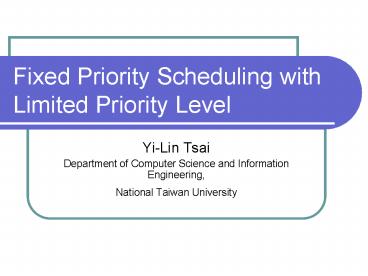Fixed Priority Scheduling with Limited Priority Level - PowerPoint PPT Presentation
1 / 20
Title:
Fixed Priority Scheduling with Limited Priority Level
Description:
Other work within priority group k which has arrived by time 0 ... Case Study: Multimedia Task Set. Case Study: Multimedia Task Set ... – PowerPoint PPT presentation
Number of Views:84
Avg rating:3.0/5.0
Title: Fixed Priority Scheduling with Limited Priority Level
1
Fixed Priority Scheduling with Limited Priority
Level
- Yi-Lin Tsai
- Department of Computer Science and
InformationEngineering, - National Taiwan University
2
Introduction
- Some systems, such as network, usually support
small number of priorities. - If natural priority levels gt system priority
levels - more than one task must be grouped into the same
system priority. - can result in significantly reduced schedulable
utilization levels
3
Introduction (cont.)
- This paper introduces
- NS schedulability test with limited priorities
- to test whether a task set is schedulable under a
system with limited priorities. - Degree of schedulable saturation
- to evaluate the impact of task groupings when
priority levels are limited.
4
Background
- Sufficient Schedulability Condition with
Unlimited Priorities - If
- gt the task set is schedulable.
5
Background (cont.)
- Sufficient Schedulability Condition with Limited
Priorities - ln(2G) 1 G when G gt ½
- U
- G when G ½
- The system has a priority grid L0, L1, L2,.,
Lk, where each Li is assigned a task period - Lk is the largest period in the task set and L0
is the smallest period - If a task has a period T such that Li-1 lt T
Li, it is assigned priority Li-1
6
Background (cont.)
- Relative schedulability
- ln(2/r) 1 1/r/ln2 when r
lt 2 - Rs
r 1/G - 1/(r ln2) when r 2
7
Background (cont.)
- NS Schedulability Condition with Unlimited
Priorities - The cumulative work arrived from priority levels
1 to i in the time interval 0, t is given by - If , the task set will meet its
deadlines if
8
Mapping Natural Priorities to Priority Groups
- There is a surjective mapping between tasks and
priority groups - Each group contains at least one task.
- If task ti gk and task tj gl, and k ! l
then - If P(ti) gt P(tj) then it must be the case that k
lt l, - If P(ti) lt P(tj) then it must be the case that k
gt l, or - If P(ti) P(tj) the either k 1 l or l 1
k - The total number of ways n task can be arranged
into m priority groups is
9
NS Schedulability Condition with Limited
Priorities
- If ti arrived at time 0, the total worst case
cumulative work that must be completed before ti
completes execution at some time interval 0, t
consists of - Higher priority work that arrives in the time
interval 0, t from priority groups 1 to k-1 - Other work within priority group k which has
arrived by time 0 - gt
10
NS Schedulability Condition with Limited
Priorities (cont.)
- If Di Ti, then ti will meet all its deadline if
- gt the task set will meet its deadlines if
11
Degree of Schedulable Saturation
- where
- where
- If Smax 1, then the task set is schedulable.
12
Degree of Schedulable Saturation (cont.)
- A particular scheduling situation is said better
if it results in a small Smax - Given that Smax Sj for some 1 j n, then tj
is called the limiting task. - Smax is monotonically nondecreasing when either
the demands of each task increase or the number
of tasks increases.
13
Sporadic Server vs. Smax
- The largest capacity server with period Ts which
can be added to a task set with n tasks that
maintains schedulability is given by - And
- gt
14
Sporadic Server vs. Smax (cont.)
- Then
- The limiting task, for which Si Smax, has an
associated limiting time t, at which - If kTs t, k 1,2,, then (1 Smax)Ts Cs
15
Sporadic Server vs. Smax (cont.)
- (1 Smax)Ts Cs
- Smax provides an indication of the amount of high
priority work that can be added at or above the
priority of the limiting task - Minimizing Smax maxizes the capacity of the
sporadic server
16
Relative Schedulability
- Relative schedulability, Rs, is defined as
follows - Rs Smax/Smax if Smax 1
- Rs 0 otherwise
- A scheduling approach is preferable if it
minimizes Smax - Finding the best mapping is an exponental search
problem.
17
Case Study Multimedia Task Set
- Smax 0.6805
18
Case Study Multimedia Task Set
- Minimum Smax 0.6805
19
Case Study Multimedia Task Set
20
Case Study Multimedia Task Set
- Assume tj is the limiting task with unlimited
priorities. A task set will suffer no loss in
schedulable utilization (Smax Smax), if - The limiting task when the system has limited
priority levels is also tj, and - tj is either in a priority group by itself or is
the lowest natural priority task in its group































